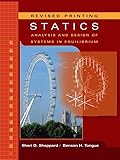Statics : analysis and design of systems in equilibrium / Sheri D. Sheppard, Benson H. Tongue ; with special contributions by Thalia Anagnos.
Material type: TextPublisher: Hoboken, NJ : Wiley, ©2007Description: xx, 636 pages : color illustrations ; 27 cmContent type: text Media type: unmediated Carrier type: volumeISBN: 0471947210; 9780471947219Subject(s): Mechanics | Statics | Equilibrium | Equilibrium | Mechanics | StaticsDDC classification: 620.103 | 531.12 LOC classification: QA821 | .S44 2007Summary: Engineering mechanics encompasses the study of whether and how objects move. Its underlying concepts, principles and procedures form the basis of much of engineering practice. This book is appealing in that it presents mechanics as a relatively uncluttered "science". Part I offers an accessible overview of the concepts of mechanics. While important equations are introduced, the emphasis is placed on clearly explaining forces and moments, and how loads are transferred through structures and machines. This introduction helps lay a motivational framework for the more mathematically complete presentation of statics found in Part II.
TextPublisher: Hoboken, NJ : Wiley, ©2007Description: xx, 636 pages : color illustrations ; 27 cmContent type: text Media type: unmediated Carrier type: volumeISBN: 0471947210; 9780471947219Subject(s): Mechanics | Statics | Equilibrium | Equilibrium | Mechanics | StaticsDDC classification: 620.103 | 531.12 LOC classification: QA821 | .S44 2007Summary: Engineering mechanics encompasses the study of whether and how objects move. Its underlying concepts, principles and procedures form the basis of much of engineering practice. This book is appealing in that it presents mechanics as a relatively uncluttered "science". Part I offers an accessible overview of the concepts of mechanics. While important equations are introduced, the emphasis is placed on clearly explaining forces and moments, and how loads are transferred through structures and machines. This introduction helps lay a motivational framework for the more mathematically complete presentation of statics found in Part II.
| Item type | Current library | Call number | Copy number | Status | Notes | Date due | Barcode |
|---|---|---|---|---|---|---|---|
 Books
Books
|
Female Library | QA821 .S44 2007 (Browse shelf (Opens below)) | 1 | Available | STACKS | 51952000318422 |
Browsing Female Library shelves Close shelf browser

|

|

|

|

|

|

|
||
| QA805 .G653 2006 Classical mechanics : an undergraduate text / | QA806 .B476 2016 The best writing on mathematics. 2015 / | QA808.5 .J64 2016 Analytical mechanics for relativity and quantum mechanics / | QA821 .S44 2007 Statics : analysis and design of systems in equilibrium / | QA9 .D863 2007 Transition to higher mathematics : structure and proof / | QA9 .D863 2007 Transition to higher mathematics : structure and proof / | QA9 .S755 2015 The foundations of mathematics / |
"Revised printing."--Cover.
Includes bibliographical references (page 50) and index.
Engineering mechanics encompasses the study of whether and how objects move. Its underlying concepts, principles and procedures form the basis of much of engineering practice. This book is appealing in that it presents mechanics as a relatively uncluttered "science". Part I offers an accessible overview of the concepts of mechanics. While important equations are introduced, the emphasis is placed on clearly explaining forces and moments, and how loads are transferred through structures and machines. This introduction helps lay a motivational framework for the more mathematically complete presentation of statics found in Part II.
2

There are no comments on this title.